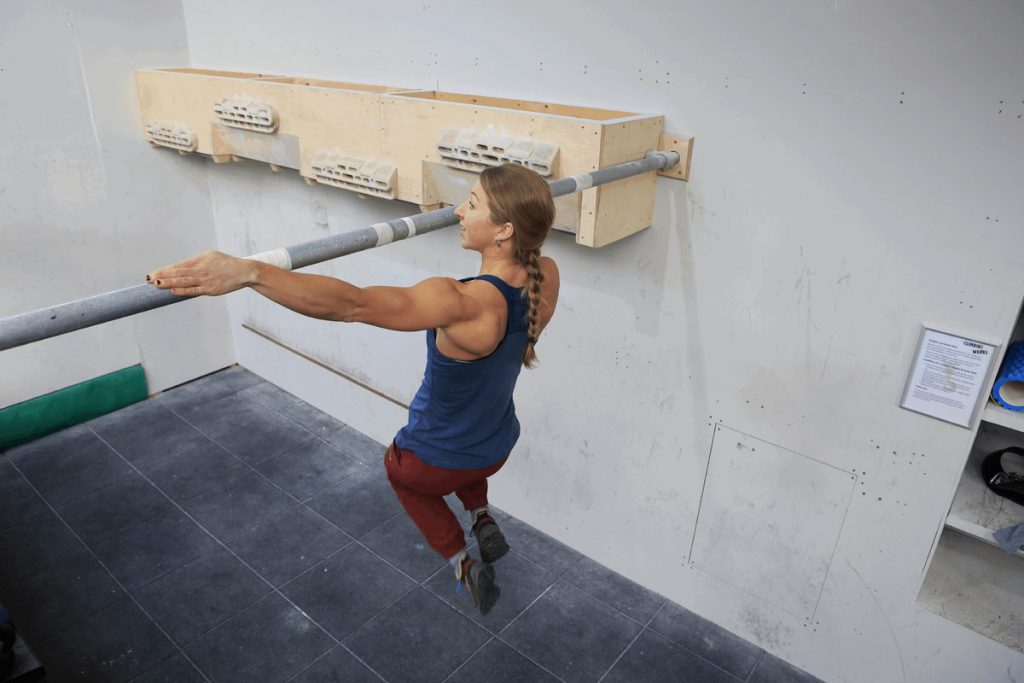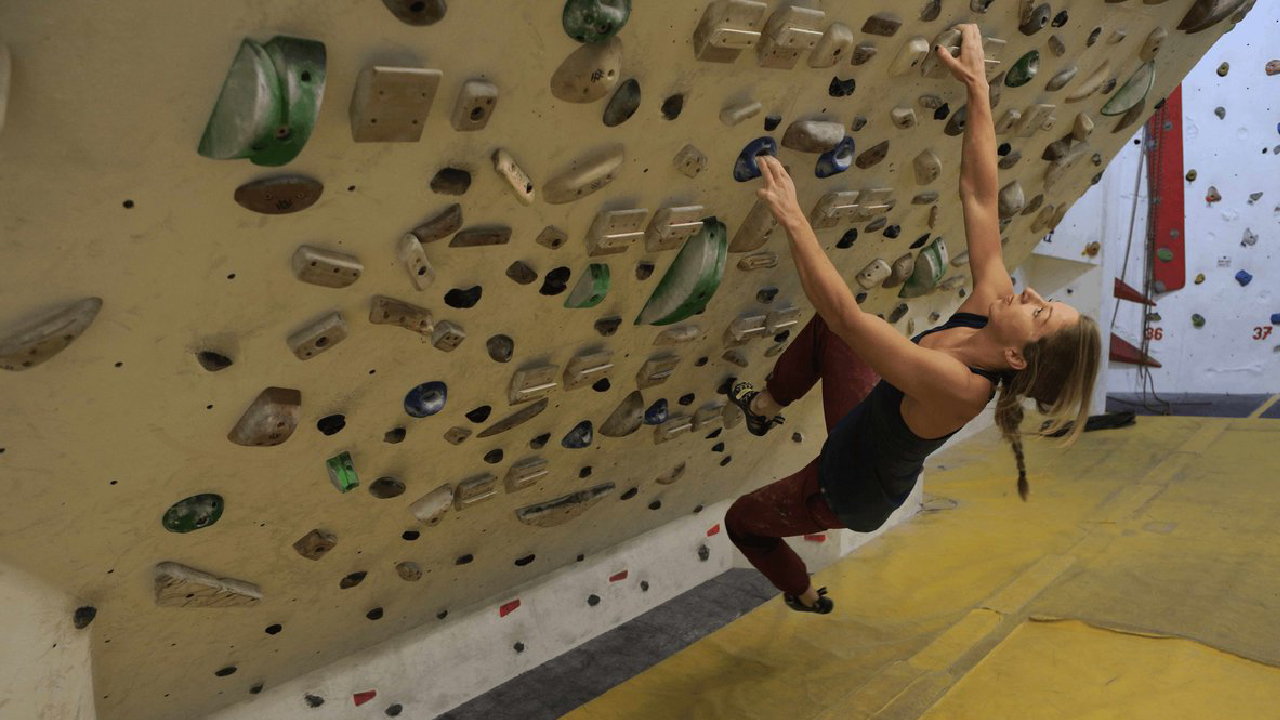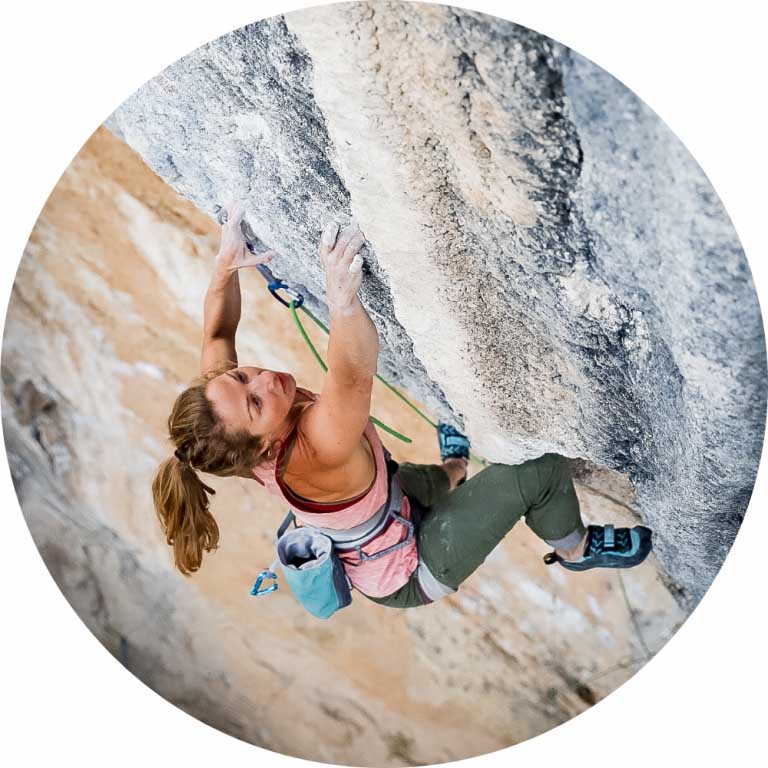Optimising Strength Training and The Menstrual Cycle (Part 2)
Previously we talked about the Gain and Maintain approach to strength training around the menstrual cycle. Gain the strength during follicular phase, maintain during the luteal phase.
In this article, Coach Maddy Cope continues the conversation, focusing on the luteal phase. Although climbing often demands both endurance and strength, strength will always be a key player. If you can’t do a move, there is nothing to endure! Hormones fluctuate throughout the entire cycle, not just during our period or premenstrual phase. We may be able to adjust how we approach training throughout to work with our physiology.
Strength training in the high hormone phase
“I like to think of hormones as another set of conditions for the climb”
Adaptations to strength training may be lesser during the luteal phase due to the higher levels of progesterone and increased recovery times. However, this does not mean we should not do any strength training during our luteal phase. Climbing is very much a strength based sport. So rather than avoiding strength training, we should be thinking about how to get the most out of the strength sessions we do during our luteal phase.
To do this, there are a number of adaptations we can make;
1) Ensure carbohydrate intake approx. 1 hour before high intensity training to mitigate the glycogen sparing mode our bodies are in.
During the luteal phase our bodies burn more fat during exercise, which is often coined “glycogen sparing”. Glycogen and glucose are the mains fuels for high intensity exercise, not fats. So this can make high intensity efforts feel less readily available during the luteal phase. Making sure our bodies have glucose readily available for high intensity training sessions could help performance and to feel less sluggish.
2) Have protein pre-training and post-training to reduce muscle protein breakdown.
The idea behind the pre-training protein is to reduce protein breakdown during exercise. However, this pre-training protein can probably be side-stepped if we have enough carbohydrates before we train. Before you think “I definitely eat enough protein/carbohydrate” it is worth emphasising that a study showed the majority of climbers were under-fueling. So adding some protein and carbohydrates before and after training, no matter what our menstrual cycle is doing, is probably not going to do us any harm.
The higher hormone levels during the luteal phase cause a small increase in resting metabolic rate (RMR). This may mean that climbers could benefit from slightly increasing intake, especially around training. This is the phase where things such as cravings are often experienced. Perhaps if we instead chose to increase our overall intake slightly we wouldn’t crave foods, and we might perform better in our training sessions.

3) Use RPE and focus on the intention of the training session.
We often use grades or weights to help us find the right intensity for a given training session. However, fluctuations in energy are commonly experienced during the menstrual cycle. So sticking rigidly to the intensity we have used from one week to the next may lead to frustration, inconsistency in training, and unnecessary fatigue.
Let’s take the example of Boulder Triples. During the follicular phase you feel good and use V5’s. The following week this feels too hard and you are failing early in the session. There are a couple of options. Continue and get frustrated, rearrange for another day, or adjust and focus on getting the right level for that session. Focusing on the intent of the session rather than the grade of climb used or weight added means we can hit the right intensity for that day. This might look like focusing on achieving the powered out feeling during a Boulder Triples session, rather than the grade of problem you are using. The aim with training is to see a general trend of progression over time. And this is rarely linear from one session to the next (menstrual cycle or no menstrual cycle!).
Focusing on this intention in the session rather than external weights or grades, can also help us avoid the negative thought pattern that can arise with fluctuations in training; “I am weak” or “I’m rubbish at training”. Avoiding these sorts of negative self-talk is a good step to take to enjoy training as well as be more consistent and likely make better progressions. I am not saying to avoid noting the weights or level of boulder problem as this information is of course useful, but checking in with this after a couple of cycles will likely give a better idea of progression.
A large component of the positive response from athletes when learning more about their cycle and how it impacts their training, is simply the understanding itself. It may be that despite training sessions feeling harder, and the RPE being higher than a previous session, the understanding of why this is, is enough to motivate you to push through. As long as this isn’t done to excess, and doesn’t cloud an objective view of training load and recovery, then this can be really empowering.
4) Account for water weight, especially if this is a significant percentage of the total added load in exercises such as fingerboarding.
Both estrogen and progesterone affect water balance in the body, and high hormone levels can lead to water retention. One mechanism for this is the increase in aldosterone with estrogen, which causes more sodium to be reabsorbed. When sodium is retained, water is also retained in order to maintain the osmotic concentration of blood (a measure of the concentration of dissolved substances in the blood). This obviously has an impact on weight, and given the weight-dependent nature of climbing could lead to increased RPE and seemingly reduced performance on weighted exercises such as weighted pull ups or fingerboarding, as well as climbing itself.
There is some information out there about mitigating water retention with reduced sodium intake, increased potassium intake, and mild diuretic use. However, I think a more sustainable approach is to simply be aware of this change and if you feel it is affecting your training adjust your session accordingly.
Weight can be a sensitive topic in climbing and I am not suggesting that everyone should weigh themselves everyday of their luteal phase, or use absolute loads in weighted exercises. However, there is a middle ground between struggling blindly on with a load, and weighing yourself every session. If through tracking bloating or water retention is something you notice and it impacts the quality of your training e.g. you can’t maintain your fingerboard load, then firstly, you can exercise some self-compassion (thinking “ok, I am a bit heavier due to water retention, and this is not a permanent thing” is better than “I am getting weaker” or “I am putting on weight”) and secondly you can reduce your added weights a little and try and aim for the same RPE.
5) Consider session length and be aware of combining too many training modes in one session.
A lot of us climbers are guilty of wanting to improve at everything at once. We want to be stronger and more powerly for boulders or cruxes, but we want better endurance so we can make it to the chains. There is a method in this madness, as a lot of climbing requires both endurance and strength, therefore, a lot of climbers look to train these elements alongside each other.
So what has this got to do with the menstrual cycle? When both strength and endurance are trained alongside each other there can be some interference (this is known as the interference effect). This is the reduction in strength gains that can be seen when we train endurance and strength alongside each other and in close proximity (i.e. in the same session). As with most things in sports science this is a complex phenomena and the impact on any given individual depends on a lot of factors. However, if we want to maximise our strength training and feel like recovery is slower during any menstrual cycle phase then one thing we can try is separating our strength and endurance training such that we complete them on different days. On a really basic level this tends to reduce the volume of a given session, which may reduce recovery time.
If strength training is a focus (which it is likely to be for a lot of climbers), and particularly if you are someone who doesn’t see fast, consistent progress in this area, then I think this is something worth being aware of. Similar to the protein advice, this is something that could be done throughout training, but may be particularly useful when strength training during the luteal phase.

Is the high hormone phase a good time to focus on endurance?
The high hormone phase, and progesterone in particular, can seem like the “baddies” when it comes to training and physical performance. However, there is some evidence that endurance ability and gains from endurance training are increased due to increased fat metabolism during exercise. Fats are used as fuel in the aerobic energy system, so training sessions that favour our aerobic energy system may feel more accessible. Furthermore, choosing to focus on training endurance during this time may be a way to optimise training from an adaptation point of view. This can be a good thing to keep in mind when reframing the high hormone phase, as I must admit it can come across as the “lesser” phase.
But what do I mean by endurance training?
This doesn’t necessarily mean going running, doing endless laps, or continuity traversing for an hour straight. Climbing is a high intensity sport and therefore we will rely on the anaerobic energy system heavily. The energy systems as we define them – aerobic and anaerobic – are not binary in the way that these definitions can lead us to believe. The main aim for our muscles is to supply ATP in order to do exercise, and they are not “fussy” per say when it comes to the source of the ATP. However, the ability for us to use the different energy systems to supply the ATP is dictated by the rate at which ATP needs to be supplied to maintain the effort.
The anaerobic system provides ATP at a much faster rate than the aerobic system, and therefore is the dominant energy system for high intensity exercise. Generally speaking if we start to reduce the intensity of exercise the aerobic system will start to contribute more (there are numerous ways of turning the dial when it comes to energy systems, including intensity, volume and rest intervals, but I won’t go into those here!). However, we need to keep our climbing goals in sharp focus here – a boulderer choosing to complete endless laps just because they are in their luteal phase is not going to optimise training!
Remember these are shifts in training focus and do not represent all aspects that will be trained during these phases.
But what does this all like on paper?
When it comes to climbing, and the luteal phase, what options are there for a climber who experiences slower recovery and feels like that top end of strength is hard earnt (or seems to have gone missing temporarily).
“I am a British sport climber, so although I need strength for the cruxes, I also need to be fit enough. During my luteal phase I feel more sluggish and tired, and struggle with maximal efforts”
- Try replacing a strength session with an endurance session, such as an aerobic capacity session, as this energy system is important for sport climbing. This increases recovery time between high intensity sessions, and potentially allows you to work with your physiology when it comes to endurance gains.
- You could reduce the length of sessions or sets/reps in higher intensity, strength based bouldering or conditioning sessions.
- You could aim to keep loads for exercises such as pull ups or fingerboarding consistent throughout the luteal phase so that you are maintaining rather than trying to push all elements of training during this phase.
I will be clear that the following are ideas, partly from my experience working with climbers, but also from my personal experience. It may be that trying out one of these adjustments and seeing if a positive change in motivation, energy levels, recovery, and/or consistency occur over around 3 cycles. This area is in its infancy in climbing (and most other sports!), so it is something to be approached with a curious and experimental mindset.
If you have any questions or want to learn more about this topic, join the Lattice Women’s Training Facebook community page.






